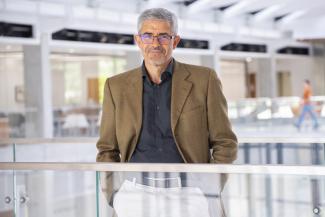
This news feature is part of Dell Med's Voices, a series of profiles that highlight the people of Dell Med as they work to improve health with a unique focus on our community.
How can a computer help someone regain motor function? José del R. Millán, Ph.D., a professor in Texas ECE and the Dell Medical School Department of Neurology, tackles this question as he designs brain-computer interfaces that empower people to surpass their limits.
Q&A
What’s the problem you’re trying to solve, and how did you come to recognize it?
Stroke is the major cause of motor disabilities in developed countries, creating considerable strain on patients and their families. Many stroke, cerebral accident and spinal cord injury patients remain with severe motor deficits and have limited treatment options.
In the mid ‘90s I was working on robotics and artificial intelligence, wondering how humans could intuitively interact with robots. By chance, I met a couple of severely paralyzed people and encountered the nascent field of brain-computer interfaces, which made me wonder: Why not decode people’s intent from their brain signals so that robots execute what they cannot? Since then, BCI has become my passion.
Today, we are still far from achieving the full potential of BCI: providing natural brain control to maximize recovery. The next quantum leap in neurotechnology requires multidisciplinary teams — engineers, therapists, neurologists and neurosurgeons, to name a few — that put the patient at the center and work with her as a critical team player.
What needs to happen to change this in Austin and the world?
This is already happening in Austin, thanks to the vision of leaders at Dell Med and others across The University of Texas at Austin. I want to acknowledge David Paydarfar, M.D., chair of the Department of Neurology, who laid the groundwork so our scientists and engineers can collaborate on the future of clinical neurology.
The Mulva Clinic for the Neurosciences will crystallize this revolution where advances in brain sciences, clinical practice, neuroengineering and artificial intelligence merge to deliver personalized interventions via wearable or minimally invasive devices.
This convergence is ongoing worldwide, but what inspires us is that interventions will provide feedback to patients. This means that patients know how devices react to their neural state and clinical teams can personalize technology to behave in the way each patient prefers.
What is your team doing to advance brain-computer interfaces?
Thanks to an incredible team of lab members and collaborators from across UT Austin, we are launching studies involving stroke patients and people with severe paralysis, combining brain-computer interfaces with technology that acts directly on nerves. My colleagues’ know-how reinforces our BCIs, and in turn, our BCIs advance their approaches. This is the beauty and the intellectual excitement of research at UT Austin: We thrive together.
The New York Times asks readers to tell their “Tiny Love Stories” in just 100 words. What’s yours?
Despite many years designing BCIs and training people with motor disabilities to operate them, it's always an emotional moment when they achieve control. Yet, these devices are largely research enterprises that people cannot take home. This is frustrating.
One day, I met a person who was finishing his training with one of our interfaces. He had an almost-paralyzed arm and hand from a stroke. He smiled at me and started to move his once-paralyzed arm in all directions, shouting: “Look, professor, look, I recovered my arm!”
What better BCI than the one that ultimately renders itself useless by successfully recovering a patient’s function?
